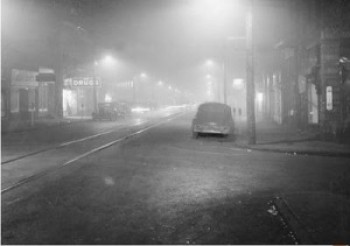The EPA claims airborne fine particulate matter kills tens of thousands annually and that the prevention of those deaths will provide society $2 trillion annually in monetized health benefits by 2020.
But we can debunk those claims with more than mere criticisms of EPA's statistical malpractice and secret data. We have actual data that simply discredit the EPA's claims.
Everyone (including environmental zealots) agrees that the worst air-pollution episode ever to occur in the United States occurred in Donora, Pa., in October 1948.
 Daytime in Donora, late-October 1948
Daytime in Donora, late-October 1948
For three days, an unusual and stifling temperature inversion trapped noxious fumes from local industry in Donora's valley. By the time rain finally came to clear away the smog, thousands had been affected, hundreds had been sickened, and 20 elderly persons were dead. The Donora tragedy was a sentinel event on the path to the federal Clean Air Act that finally was enacted in 1963.
Ironically, though, when the Donora episode is studied rather than simply exploited as a rhetorical device, that debunks the EPA's assertion that present-day air quality is a killer.
The U.S. Public Health Service investigated the Donora tragedy and in 1949 issued a report titled "Air Pollution in Donora, Pa.: Epidemiology of the Smog Episode of October 1948."
The report indicates that the death rates for the period 1945-48 for Donora and nearby Pittsburgh were 826 and 1,086 per 100,000 people, respectively.
Surprisingly, those mortality rates compare pretty well with the most recent mortality data for Allegheny County, Pa., home to both Donora and Pittsburgh.
During the years 2006-08, Allegheny County's mortality rate was 1,110 per 100,000. And while mortality rate is one of the few objective public health statistics available, there's much more to this story than simply comparing then-and-now mortality rates.
Donora's air quality was measured by the U.S. Weather Bureau from Feb. 16 to April 27, 1949 -- i.e., more than three months after the October inversion and during what would be considered normal air-quality conditions in Donora.
The Weather Bureau's measurements of airborne particulate matter are astonishing and compelling. Of the 205 air samples taken at 12 stations during those 10 weeks in Donora, 54 percent exceeded 500 micrograms per cubic meter.
While the other 46 percent of the readings were less than 500 micrograms per cubic meter, it's likely that all of those were likely far greater than today's EPA's standard for maximum allowable fine particulate matter, which is 35 micrograms per cubic meter during a 24-hour period.
In contrast, Allegheny County violated this modern EPA standard just twice during 2007-09.
So, although the air in Allegheny County is much cleaner than it was in the years following World War II, the mortality rate is about the same.
Moreover, the mortality rate in Donora from 1945-48 was 26 percent lower than the 2006-08 death rate in surrounding Allegheny County, despite the fact that the air was far dirtier as measured by the Weather Bureau in 1949, when more than half the time it exceeded the current EPA standard by a factor of 14 or more.
So what happened in Donora? The unusual inversion trapped toxic chemical fumes from facilities that did not cease operations until conditions had reached obviously toxic levels. The 20 elderly people who died in Donora (mean and median age 65) were all already suffering chronic heart and lung disease.
Autopsies indicated that unknown substances caused the deaths, which the Public Health Service's report analogized to the World War I chemical weapon phosgene. There was no evidence that particulate matter caused any deaths.
Although the Donora tragedy could not occur today because of stringent air-toxins regulations, modern emissions-control technology, vastly improved medical care and the societal wealth to afford it all, the EPA nonetheless likes to pretend that today's air quality is as poor and dangerous as it ever was and that we are all just one orange or red air-quality day away from death.
The agency's remedy is a slew of new regulations -- such as its imminent ozone rule, which is estimated to be the most expensive regulation ever, costing $1 trillion annually in real compliance costs after 2020 and killing as many as 7.4 million actual jobs.
In November 1950, the Public Health Service's Donora report was reviewed in the Journal of the American Medical Association, which observed, "There is need to know whether there is an insidious effect on those living their lifetime under an industrially polluted sky. Statistical studies of death rates in industrial cities are not sufficient. The situation requires the best in investigative medicine."
While no one in America anymore lives under an "industrially polluted sky," the call for "investigative" medicine 60 years ago still has not been answered. Instead, the EPA has spent tens and perhaps hundreds of millions of dollars cooking up dubious statistical claims about air quality without ever checking to see if they match up with reality.
If the EPA seriously maintains that its existing and new air regulations are providing trillions of dollars' worth of health benefits, it should be compelled to produce hard medical evidence of those claimed benefits.
Sixty-three years ago, the Donora tragedy alerted society that air could become deadly in certain situations. It helped America choose a path toward the clean air we have now.
We can recycle the lesson of Donora. This time, however, we must make sure we don't allow an out-of-control EPA to wreck our economy and kill jobs with overly stringent regulations that only "prevent" imaginary deaths and illness at real and significant costs that we can't afford.
Steve Milloy publishes JunkScience.com and is the author of "Green Hell: How Environmentalists Plan to Ruin Your Life and What You Can Do to Stop Them" (Regnery, 2009). Dr. John Dale Dunn is an emergency physician in Texas.